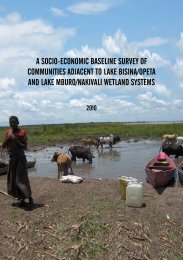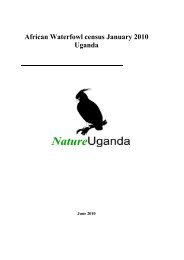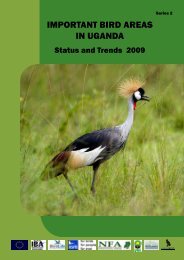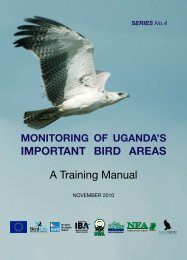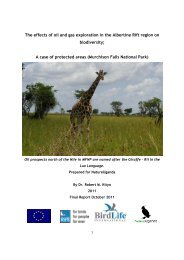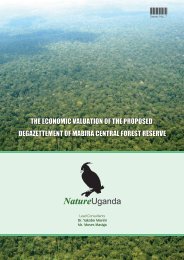A Ecological Baseline Surveys Of: - Lake Bisina - Nature Uganda
A Ecological Baseline Surveys Of: - Lake Bisina - Nature Uganda
A Ecological Baseline Surveys Of: - Lake Bisina - Nature Uganda
Create successful ePaper yourself
Turn your PDF publications into a flip-book with our unique Google optimized e-Paper software.
and Sironko. The species list for this wetland system has about 234 species (Appendix 4) is a<br />
combination of our survey, the Ramsar survey and the waterfowl count records.<br />
2.5.2 RESULTS AND DISCUSSION<br />
A total of 194 species of birds were recorded during the survey conducted in this area (Appendix 2).<br />
These included 41 migratory species and 26 species of conservation concern (Threatened species).<br />
The migratory species included nine Afro-tropical migrants, 31 Palearctic migrants and one species<br />
which is both an Afro-tropical and Palearctic migrant (Table 3). The majority of species recorded in<br />
this area are Wetland species or species associated with the wetland habitat. However one forest<br />
specialist and eight forest generalists were also recorded in this area.<br />
Table 3: Species recorded in the different habitat and migratory classes<br />
in the Opeta-<strong>Bisina</strong> wetland system<br />
Habitat Species<br />
F 8<br />
f 22<br />
FF 1<br />
G 19<br />
W 79<br />
Migration<br />
A 9<br />
P 31<br />
PA 1<br />
Among the threatened species recorded are six species of global concern and 20 species of<br />
regional concern (Table 4). The species of global concern include three globally and regionally<br />
vulnerable species Shoebill (Balaeniceps rex), White-headed Vulture (Trigonoceps occipitalis) and<br />
Lesser Kestrel (Falco naumanni), two globally and regionally near threatened species Fox’s Weaver<br />
(Ploceus spekeoides) and Pallid Harrier (Circus macrourusi) and one globally near threatened species<br />
Bateleur (Terathopius ecaudatus).<br />
The most abundant species in this area included the Woolly-necked Stork (Ciconia episcopus),<br />
African Pied Wagtail (Motacilla aguimp), Hadada (Bostrychia hagedash), Red-knobbed Coot (Fulica<br />
cristata), Spotted Flycatcher (Muscicapa striata), Chubb’s Cisticola (Cisticola chubbi), Yellowrumped<br />
Tinkerbird (Pogoniulus bilineatus), Yellow-throated Leaflove (Chlorocichla flavicollis) and<br />
African Black Swift (Apus barbatus), all with abundances of 6 (Appendix 2).<br />
The presence of these sensitive species in the area, which include migrants, species of conservation<br />
concern and forest specialist, indicates that this wetland is very important in the conservation of the<br />
birds in the country and the world as a whole due to the presence of a noticeably high number of<br />
migrants. These species are usually considered as the indicator species for environmental health.<br />
The conservation plan of this area should therefore put into consideration the habitats of these<br />
species and ensure that they are conserved for the sustainability of their global populations.<br />
The Fox’s Weaver P spekeoides, <strong>Uganda</strong>’s only endemic was recorded breeding in this area during<br />
the counts done in 2001, but new records of this species have been very rare in recent visits. Further<br />
efforts are needed to ascertain the population size of this species and ensure that its conservation<br />
is prioritized.<br />
<strong>Ecological</strong> <strong>Baseline</strong> <strong>Surveys</strong> of <strong>Lake</strong> <strong>Bisina</strong>, <strong>Lake</strong> Opeta, <strong>Lake</strong> Mburo and Nakivali Wetlands Systems 15



